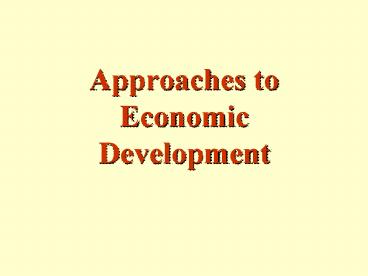Approaches to Economic Development - PowerPoint PPT Presentation
1 / 26
Title:
Approaches to Economic Development
Description:
Industrialization through import substitution in which countries such as Nigeria ... Duality. Insufficiency. Financial System. Formal Financial Markets ... – PowerPoint PPT presentation
Number of Views:77
Avg rating:3.0/5.0
Title: Approaches to Economic Development
1
Approaches to Economic Development
2
We can Summarize the Approaches to Development as
Follows
- Industrialization through import substitution in
which countries such as Nigeria tried to replace
imports with home-made goods. - Labor-intensive techniques.
- Income distribution approaches.
3
- Provision of basic human needs to the poor
- Market-oriented approaches
- Development following revolution that eliminates
existing elite and establishes a command economy.
4
- Massive resource shifts in form of foreign aid
and investment from rich to poor countries.
5
5 Basic Approaches to Development
- Trickle-down Approach
- Foreign aid, private investment, and expanded
trade opportunities - Basic Human Needs Approach
- Based on development assistance and credit
- led to the debt crisis
6
- Structural Adjustment
- Based on imposed solutions of economic reforms
- Self-Reliance and Producing for Local Needs
- Integration and cooperation
- Sustainable Development
- based on long-term development
7
Trickle-down Approach
- This approach believes that take-off would come
from large amounts of foreign aid, private
investment, and expanded trade opportunities and
the benefits would trickle down to even the
poorest members of each society
8
Failure of Trickle-down
- Failed because of
- the concentration of economic resources in the
hands of the rich and unrepresentative governments
9
- the exclusion of the large majority of affected
populations from economic decision-making
10
- the integration of developing countries
economies in an international marketplace in
which they could not compete equitably
11
The Painful Road to Macroeconomic Stability
- Macro stabilization has three main objectives
- controlling inflation
- restoring fiscal balance by reducing governmental
spending and by raising government tax revenues - eliminating the current account deficit by means
of devaluation and export promotion
12
Financial Systems and Monetary Policy
- Differences between MDC and LDC financial systems
- The role of central banks
- The emergence of development banking
- The role of informal finance for small-scale
enterprise
13
Characteristics
- Smallness
- Duality
- Insufficiency
14
Financial System
Informal Financial Markets Outside of the state
financial laws
Formal Financial Markets Under the control of
state credit financial laws
- Work Occupational associations
- Savings and credit Associations
- Insurance and burial associations
- Community development associations
- Individual financial brokers
- Commercial Banks
- Development Banks
- Savings Credit Banks
- Cooperative Banks
15
Banking
- Virtually every country has a central bank
- Commercial banking is characterized by
- Low banking density
- Concentration in urban centers
- Rigid loan conditions
- Rationing
16
Currency Issues
- Multiplicity of currencies
- With the exception of a few currencies such as
the Franc CFA in some francophone African
countries, virtually each country has its own
currency - Almost none of them is convertible
17
Role of Central Banks
- Issuer of currency
- Banker to government
- Banker to commercial banks
- Regulator of financial institutions
- Operator of monetary policy
- Promoter of financial development
18
Emergence of Development Banking
- Development banks are specialized public and
private financial institutions that supply
medium- and long-term funds for the creation or
expansion of industrial enterprises.
19
Case African Financial Markets
- More than 18 Stock Exchanges in Africa
- With a combined market capitalization of just
over 280 billion at the end of 1997 - The Johannesburg Stock Exchange (JSE) in South
Africa is by far the largest, accounting for
around 234 billion in 1997
20
Reforming LDC Financial System
- Financial liberalization, real interest rates,
savings, and investment - Interest rates often kept artificially low to
encourage investment - Interest rate ceilings lead to credit rationing
and excess demand which, in turn leads to
financial repression (limiting of investment
because of shortage of savings)
21
Financial Policy
- Deals with money, interest, and credit allocation
- Also involves monetary policy
- the deliberate altering of a countries money
supply to for the purpose of bringing about
economic growth, increasing employment or,
stabilizing prices.
22
- Removal of artificially low nominal interest rate
ceilings generates more domestic savings. - Higher interest rates allocates loanable funds to
the most productive projects - Direct initiatives to channel credit to small
entrepreneurs is also essential - may require new types of financial intermediaries
oriented toward the traditional or informal
sector.
23
Fiscal Policy
- Focuses on government taxation and expenditure
- Deliberate manipulation of taxes and government
spending to alter real domestic output and
employment, control inflation and stimulate
economic growth
24
- Most stabilization attempts have concentrated on
cutting government expenditures to achieve
budgetary balance - The mobilization of resources to finance public
expenditures is the most important purpose of
taxation
25
Tax Sources
- Taxes can be
- Direct taxes--those levied on private
individuals, corporations, and property - Indirect taxes--such as import and export duties
and excise taxes - Personal income and property taxes
- Corporate income taxes
- Indirect taxes on commodities
26
Public Administration the Scarcest Resource
- Managerial/administrative capability is scarce
because of - a lack of training or experience
- political instability
- Class, ethnic, or religious conflict make public
administration difficult - Bureaucracies are often overstaffed at the bottom
and understaffed at the top































